Mapping Homogeneous Response Areas for Forest Fuel Management Using Geospatial Data, K-Means, and Random Forest Classification
Abstract
1. Introduction
2. Materials and Methods
2.1. Study Area
2.2. Data Description
- I.
- Climate data: It is considered as an important element determining vegetation characteristics, and it is fundamental for forest fuel production [35]. Climate information regarding average annual precipitation and average annual temperature was processed using the Agroclimatic Information System for Mexico-Central America (SIAMEXCA); this consists of a historical series of climatic databases from 1961 to 2010 with spatial resolution of 185 m [36].
- II.
- Altitudinal gradient: It is an important element that influences diversity and species composition of ecosystems [37]. Altitude information was derived from the 30 m spatial resolution digital elevation model (DEM) provided by the Shuttle Radar Topography Mission (SRTM) using single-pass C-band interferometric synthetic aperture radar (InSAR) techniques [23].
- III.
- Canopy characteristics: Forest canopy height and forest canopy cover are highly important to estimate forest fuel loads because they significantly describe the structure of the fuel complex [38,39], and potential crown fire propagation [7,40]. The highest values of tree height and canopy cover, probably determined the scarce vegetation in the understory, mainly as a result of solar radiation transmitted through the canopy [41,42].
2.3. Identification of HRAs in Each Study Area
2.4. Mapping the Spatial Distribution of HRAs in the Study Areas
3. Results
3.1. Identification of HRAs in Each Study Area
3.2. Spatial Distribution of HRAs
4. Discussion
4.1. Identification of HRAs in Each Study Area
4.2. Spatial Distribution of HRAs in the Study Areas
5. Conclusions
Author Contributions
Funding
Acknowledgments
Conflicts of Interest
References
- Pyne, S.J.; Andrews, P.L.; Laven, R.D. Introduction to Wildland Fire, 2nd ed.; Wiley: New York, NY, USA, 1996. [Google Scholar]
- Sullivan, A.L. Wildland Surface Fire Spread Modelling, 1990–2007. 3: Simulation and Mathematical Analogue Models. Int. J. Wildland Fire 2009, 18, 387–403. [Google Scholar] [CrossRef]
- Rothermel, R.C. A Mathematical Model for Predicting Fire Spread in Wildland Fuels; Intermountain Forest & Range Experiment Station, Forest Service, US Department of Agriculture: Ogden, UT, USA, 1972.
- Keane, R.E. Wildland Fuel Fundamentals and Applications; Springer International: New York, NY, USA, 2015. [Google Scholar]
- McKenzie, D.; Raymond, C.L.; Kellogg, L.K.B.; Norheim, R.A.; Andreu, A.G.; Bayard, A.C.; Kopper, K.E.; Elman, E. Mapping Fuels at Multiple Scales: Landscape Application of the Fuel Characteristic Classification SystemThis Article Is One of a Selection of Papers Published in the Special Forum on the Fuel Characteristic Classification System. Can. J. For. Res. 2007, 37, 2421–2437. [Google Scholar] [CrossRef]
- Flores-Garnica, J.G.; Chávez-Durán, A.A.; Rubio-Camacho, E.A.; Villela Gaytán, S.A.; Xelhuantzi-Carmona, J.; Frías-Gómez, J.G. Evaluación de La Respuesta de Diferentes Ecosistemas Forestales a Los Incendios Forestales. In Informe Técnico y Financiero Segunda Etapa; Clave CONACyT: 71400; Instituto Nacional de Investigaciones Forestales, Agrícolas y Pecuarias: Guadalajara, Mexico, 2008. [Google Scholar]
- Prichard, S.J.; Andreu, A.G.; Ottmar, R.D.; Eberhardt, E. Fuel Characteristic Classification System (FCCS) Field Sampling and Fuelbed Development Guide; Forest Service, US Department of Agriculture: Portland, OR, USA, 2019. [Google Scholar] [CrossRef]
- Chávez-Durán, Á.A.; Flores-Garnica, J.G.; Luna-Luna, M.; Centeno-Erguera, L.R.; Alarcón-Bustamante, M.P. Caracteriza-ción y Clasificación de Camas de Combustibles Prioritarias En México Para Planificar El Manejo Del Fuego. Informe Técnico Fondo Sectorial CONACyT-CONAFOR. Referencia: CONAFOR-2012-C01-175523; Instituto Nacional de Investigaciones Forestales, Agrícolas y Pecuarias: Tepatitlán de Morelos, México, 2014.
- Morfin-Rios, J.E.; Alvarado-Celestino, E.; Jardel-Pelaez, E.J.; Vihnanek, R.E.; Wright, D.K.; Michel-Fuentes, J.M.; Wright, C.S.; Ottmar, R.D.; Sandberg, D.V.; Najera-Diaz, A. Photo Series for Quantifying Forest Fuels in Mexico: Montane Subtropical Forests of the Sierra Madre Del Sur and Temperate Forests and Montane Shrubland of the Northern Sierra Madre Oriental; Pacific Wildland Fire Sciences Laboratory; University of Washington, College of Forest Resources: Seattle, WA, USA, 2008; Volume, Special Pub. No. 1. [Google Scholar]
- Taherdoost, H. Sampling Methods in Research Methodology; How to Choose a Sampling Technique for Research. Int. J. Acad. Res. Manag. 2016, 5, 18–27. [Google Scholar] [CrossRef]
- Velasco-Herrera, J.A.; Flores-Garnica, J.G.; Maárquez-Azuúa, B.; Loópez, S. Áreas de Respuesta Homogénea Para El Muestreo de Combustibles Forestales. Rev. Mex. Cienc. For. 2018, 4, 41–54. [Google Scholar] [CrossRef][Green Version]
- Pinzari, L.; Mazumdar, S.; Girosi, F. A Framework for the Identification and Classification of Homogeneous Socioeconomic Areas in the Analysis of Health Care Variation. Int. J. Health Geogr. 2018, 17, 42. [Google Scholar] [CrossRef]
- Ullah, H.; Akbar, M.; Khan, F. Construction of Homogeneous Climatic Regions by Combining Cluster Analysis and L-moment Approach on the Basis of Reconnaissance Drought Index for Pakistan. Int. J. Climatol. 2019, 40, 324–341. [Google Scholar] [CrossRef]
- Palacios-Corona, V.; Vázquez-García, M.; González-Eguiarte, D.R.; Villarreal-Farías, E.; Byerly-Murphy, K.F. Technical Diagnosis for Technology Change in the Corn Crop. TERRA Latinoam. 2007, 25, 321–332. [Google Scholar]
- Reyes-Cárdenas, O.; Flores-Garnica, J.G.; Treviño-Garza, E.J.; Aguirre-Calderón, O.A.; Cárdenas-Tristán, A. Zonificación Forestal Bajo El Concepto de Áreas de Respuesta Homogénea En El Centro de México. Investig. Geográficas. 2019, 98. [Google Scholar] [CrossRef]
- Ghayour, L.; Neshat, A.; Paryani, S.; Shahabi, H.; Shirzadi, A.; Chen, W.; Al-Ansari, N.; Geertsema, M.; Pourmehdi Amiri, M.; Gholamnia, M.; et al. Performance Evaluation of Sentinel-2 and Landsat 8 OLI Data for Land Cover/Use Classification Using a Comparison between Machine Learning Algorithms. Remote Sens. 2021, 13, 1349. [Google Scholar] [CrossRef]
- Kwan, C.; Ayhan, B.; Budavari, B.; Lu, Y.; Perez, D.; Li, J.; Bernabe, S.; Plaza, A. Deep Learning for Land Cover Classification Using Only a Few Bands. Remote Sens. 2020, 12, 2000. [Google Scholar] [CrossRef]
- Zhu, L.; Spachos, P. Towards Image Classification with Machine Learning Methodologies for Smartphones. Mach. Learn. Knowl. Extr. 2019, 1, 59. [Google Scholar] [CrossRef]
- Yuvalı, M.; Yaman, B.; Tosun, Ö. Classification Comparison of Machine Learning Algorithms Using Two Independent CAD Datasets. Mathematics 2022, 10, 311. [Google Scholar] [CrossRef]
- Xie, G.; Niculescu, S. Mapping and Monitoring of Land Cover/Land Use (LCLU) Changes in the Crozon Peninsula (Brittany, France) from 2007 to 2018 by Machine Learning Algorithms (Support Vector Machine, Random Forest, and Convolutional Neural Network) and by Post-Classification Comparison (PCC). Remote Sens. 2021, 13, 3899. [Google Scholar] [CrossRef]
- Zagajewski, B.; Kluczek, M.; Raczko, E.; Njegovec, A.; Dabija, A.; Kycko, M. Comparison of Random Forest, Support Vector Machines, and Neural Networks for Post-Disaster Forest Species Mapping of the Krkonoše/Karkonosze Transboundary Biosphere Reserve. Remote Sens. 2021, 13, 2581. [Google Scholar] [CrossRef]
- Comisión Nacional de Áreas Naturales Protegidas (CONANP). Recategorización Del Área de Protección de Flora y Fauna “Sierra de Quila”; Diario Oficial: Mexico City, Mexico, 2000; pp. 1–5. [Google Scholar]
- Farr, T.G.; Rosen, P.A.; Caro, E.; Crippen, R.; Duren, R.; Hensley, S.; Kobrick, M.; Paller, M.; Rodriguez, E.; Roth, L.; et al. The Shuttle Radar Topography Mission. Rev. Geophys. 2007, 45, RG2004. [Google Scholar] [CrossRef]
- Santiago-Pérez, A.L.; Ayón-Escobedo, A.; Rosas-Espinoza, V.C.; Rodríguez-Zaragoza, F.A.; Toledo-González, S.L. Estructura Del Bosque Templado de Galería En La Sierra de Quila, Jalisco. Rev. Mex. Cienc. For. 2014, 5, 92–109. [Google Scholar]
- García, E. Climas, Clasificación de Köppen Modificado Por García; Comisión Nacional para el Conocimiento y Uso de la Biodiversidad (CONABIO): Mexico City, Mexico, 1998. [Google Scholar]
- Instituto Nacional de Estadística y Geografía (INEGI). Conjunto de Datos Vectorial Edafológico. Serie II Continuo Nacional; INEGI Aguascalientes: Aguascalientes, Mexico, 2013.
- Instituto Nacional de Estadística y Geografía (INEGI). Conjunto de Datos Vectoriales de Uso Del Suelo y Vegetación, Serie VII; INEGI: Aguascalientes, Aguascalientes, Mexico, 2021.
- Jardel-Pelaez, E.J.; Pérez-Salicrup, D.; Alvarado-Celestino, E.; Morfin-Rios, J.E. Principios y Criterios Para El Manejo Del Fuego En Ecosistemas Forestales: Guía de Campo; Comisión Nacional Forestal: Guadalajara, Mexico, 2014. [Google Scholar]
- Jiménez-Luquín, E. Sierra de Quila: ¿Cómo ha ido cambiando los últimos 25 años desde la tragedia? In Memorias. I Foro de conocimiento, uso y gestión del Área Natural Protegida Sierra de Quila; Villavicencio-García, R., Santiago-Pérez, A.L., Rosas-Espinoza, V.C., Hernández-López, L., Eds.; Universidad de Guadalajara. Centro Universitario de Ciencias Biológicas y Agropecuarias. Departamento de Producción Forestal: Guadalajara, Mexico, 2011; pp. 1–134. [Google Scholar]
- Secretaría del Medio Ambiente y Desarrollo Territorial (SEMADET). Plan Estatal de Manejo Del Fuego En El Estado de Jalisco Primera Etapa; SEMADET: Guadalajara, Mexico, 2018.
- Chávez-Durán, Á.A.; Bustos-Santana, A.; Chávez-Durán, H.M.; Flores-Garnica, J.G.; Rubio-Camacho, E.A.; Xelhuantzi-Carmona, J. Distribución espacial de cargas de combustibles en una parcela de muestreo de Pino–Encino. Rev. Mex. Cienc. For. 2021, 12, 1–22. [Google Scholar] [CrossRef]
- Comisión Nacional Forestal (CONAFOR). Unidad de Manejo Forestal 1407, Sierra de Quila. Estudio Regional Forestal; CONAFOR: Guadalajara, Mexico, 2007.
- Comisión Nacional de Áreas Naturales Protegidas (CONANP). Recategorización Del Área de Protección de Flora y Fauna “Sierra de Álvarez”; Diario Oficial: Mexico City, Mexico, 2000; pp. 1–5. [Google Scholar]
- Comisión Nacional de Áreas Naturales Protegidas (CONANP). Recategorización de La Reserva de La Biosfera “Selva El Ocote”; Diario Oficial: Mexico City, Mexico, 2000; pp. 1–13. [Google Scholar]
- Rodríguez-Trejo, D.A. Incendios de Vegetación. Su Ecología Manejo e Historia. Volumen 1; Biblioteca Básica De Agricultura (BBA): Colegio de Postgraduados, Mexico, 2014. [Google Scholar]
- Ruiz-Corral, J.A.; Medina-García, G.; García-Romero, G.E. Sistema de Información Agroclimático Para México-Centroamérica (SIAMEXCA). Rev. Mex. Cienc. Agrícolas 2018, 9, 1–10. [Google Scholar] [CrossRef]
- Stevens, G.C. The Elevational Gradient in Altitudinal Range: An Extension of Rapoport’s Latitudinal Rule to Altitude. Am. Nat. 1992, 140, 893–911. [Google Scholar] [CrossRef]
- García-Cimarras, A.; Manzanera, J.A.; Valbuena, R. Analysis of Mediterranean Vegetation Fuel Type Changes Using Multitemporal LiDAR. Forests 2021, 12, 335. [Google Scholar] [CrossRef]
- Bajocco, S.; Dragoz, E.; Gitas, I.; Smiraglia, D.; Salvati, L.; Ricotta, C. Mapping Forest Fuels through Vegetation Phenology: The Role of Coarse Resolution Satellite Time-Series. PLoS ONE 2015, 10, e0119811. [Google Scholar] [CrossRef] [PubMed]
- Keane, R.E.; Reinhardt, E.D.; Scott, J.; Gray, K.; Reardon, J. Estimating Forest Canopy Bulk Density Using Six Indirect Methods. Can. J. For. Res. 2005, 35, 724–739. [Google Scholar] [CrossRef]
- Mestre, L.; Toro-Manríquez, M.; Soler, R.; Huertas-Herrera, A.; Martínez-Pastur, G.; Lencinas, M.V. The Influence of Canopy Layer Composition on Understory Plant Diversity in Southern Temperate Forests. For. Ecosyst. 2017, 4, 1–13. [Google Scholar] [CrossRef]
- Casals, P.; Valor, T.; Besalú, A.; Molina-Terrén, D. Understory Fuel Load and Structure Eight to Nine Years after Prescribed Burning in Mediterranean Pine Forests. For. Ecol. Manag. 2016, 362, 156–168. [Google Scholar] [CrossRef]
- Global Ecosystem Dynamics Investigation (GEDI). Ecosystem Lidar. Available online: https://gedi.umd.edu/ (accessed on 27 June 2022).
- United States Geological Survey (USGS). Landsat Missions. Available online: https://www.usgs.gov/core-science-systems/nli/landsat (accessed on 28 June 2022).
- Google Earth Engine (GEE). A Planetary Scale Platform for Earth Science Data and Analysis. Available online: https://earthengine.google.com/ (accessed on 28 June 2022).
- Tun-Dzul, F.; Vester, H.; García, R.; Schmook, B. Estructura Arbórea y Variabilidad Temporal Del NDVI En Los “Bajos Inundables” de La Península de Yucatán, México. Polibotánica 2008, 25, 69–90. [Google Scholar]
- Soenen, S.A.; Peddle, D.R.; Coburn, C.A. SCS+C: A Modified Sun-Canopy-Sensor Topographic Correction in Forested Terrain. IEEE Trans. Geosci. Remote Sens. 2005, 43, 2148–2159. [Google Scholar] [CrossRef]
- Huete, A.; Didan, K.; Miura, T.; Rodriguez, E.P.; Gao, X.; Ferreira, L.G. Overview of the Radiometric and Biophysical Performance of the MODIS Vegetation Indices. Remote Sens. Environ. 2002, 83, 195–213. [Google Scholar] [CrossRef]
- Baboo, S.; Devi, R. An Analysis of Different Resampling Methods in Coimbatore, District. Glob. J. Comput. Sci. Technol. 2010, 10, 61–66. [Google Scholar]
- Thode, H.C. Testing for Normality; Chemical Rubber Company Press: New York, NY, USA, 2002. [Google Scholar]
- Xiong, Q.; Luo, X.; Liang, P.; Xiao, Y.; Xiao, Q.; Sun, H.; Pan, K.; Wang, L.; Li, L.; Pang, X. Fire from Policy, Human Interventions, or Biophysical Factors? Temporal–Spatial Patterns of Forest Fire in Southwestern China. For. Ecol. Manag. 2020, 474, 118381. [Google Scholar] [CrossRef]
- Lv, Z.; Liu, T.; Shi, C.; Benediktsson, J.A.; Du, H. Novel Land Cover Change Detection Method Based on K-Means Clustering and Adaptive Majority Voting Using Bitemporal Remote Sensing Images. IEEE Access 2019, 7, 34425–34437. [Google Scholar] [CrossRef]
- Meng, Y.; Liang, J.; Cao, F.; He, Y. A New Distance with Derivative Information for Functional K-Means Clustering Algorithm. Inf. Sci. 2018, 463–464, 166–185. [Google Scholar] [CrossRef]
- Anderson, M.J.; Ellingsen, K.E.; McArdle, B.H. Multivariate Dispersion as a Measure of Beta Diversity. Ecol. Lett. 2006, 9, 683–693. [Google Scholar] [CrossRef] [PubMed]
- Murtagh, F.; Legendre, P. Ward’s Hierarchical Agglomerative Clustering Method: Which Algorithms Implement Ward’s Criterion? J. Classif. 2014, 31, 274–295. [Google Scholar] [CrossRef]
- Rousseeuw, P.J. Silhouettes: A Graphical Aid to the Interpretation and Validation of Cluster Analysis. J. Comput. Appl. Math. 1987, 20, 53–65. [Google Scholar] [CrossRef]
- Garcia-Lopes, H.E.; De-Sevilha-Gosling, M. Cluster Analysis in Practice: Dealing with Outliers in Managerial Research. Rev. Adm. Contemp. 2021, 25. [Google Scholar] [CrossRef]
- Fox, J.; Weisberg, S. An R Companion to Applied Regression, 3rd ed.; Sage: Thousand Oaks, CA, USA, 2018. [Google Scholar]
- Vargha, A.; Delaney, H.D. The Kruskal-Wallis Test and Stochastic Homogeneity. J. Educ. Behav. Stat. 1998, 23, 170–192. [Google Scholar] [CrossRef]
- Bonamente, M. Statistics and Analysis of Scientific Data; Springer Science and Business Media: New York, NY, USA, 2017. [Google Scholar]
- Maechler, M.; Rousseeuw, P.; Struyf, A.; Hubert, M.; Hornik, K.; Studer, M.; Roudier, P.; González, J.; Kozlowski, K.; Schubert, E.; et al. Package ‘cluster.’ Finding Groups in Data. Available online: https://cran.r-project.org/web/packages/cluster/cluster.pdf (accessed on 28 June 2022).
- Kassambara, A.; Mundt, F. Package “factoextra”. Extract and Visualize the Results of Multivariate Data Analyses. Available online: https://cran.r-project.org/web/packages/factoextra/factoextra.pdf (accessed on 28 June 2022).
- Fraley, C.; Raftery, A.E.; Scrucca, L.; Murphy, T.B.; Fop, M. Package “mclust”. Title Gaussian Mixture Modelling for Model Based Clustering, Classification, and Density Estimation. Available online: https://cran.r-project.org/web/packages/mclust/mclust.pdf (accessed on 27 June 2022).
- Wright, K.; YiLan, L.; RuTong, Z. Package ‘clustertend.’ Check the Clustering Tendency. Available online: https://cran.r-project.org/web/packages/clustertend/clustertend.pdf (accessed on 28 June 2022).
- Wickham, H.; Hester, J.; Francois, R.; Bryan, J.; Bearrows, S.; Jylänki, J.; Jørgensen, M. Package ‘readr.’ Read Rectangular Text Data. Available online: https://cran.r-project.org/web/packages/readr/readr.pdf (accessed on 28 June 2022).
- Kuhn, M.; Wing, J.; Weston, S.; Williams, A.; Keefer, C.; Engelhardt, A.; Cooper, T.; Mayer, Z.; Kenkel, B.; Benesty, M.; et al. Package “caret”. Classification and Regression Training. Available online: https://cran.r-project.org/web/packages/caret/caret.pdf (accessed on 28 June 2022).
- Gross, J.; Ligges, U. Package ‘northest’. Tests for Normality. Available online: https://cran.r-project.org/web/packages/nortest/nortest.pdf (accessed on 28 June 2022).
- R Core Team. R: A Language and Environment for Statistical Computing; Version 4.1.2; R Foundation for Statistical Computing: Vienna, Austria; Available online: https://www.R-project.org/ (accessed on 28 June 2022).
- Breiman, L. Random Forests. Mach. Learn. 2001, 45, 5–32. [Google Scholar] [CrossRef]
- Python. Python Software Foundation. Available online: https://www.python.org/ (accessed on 28 June 2022).
- Biau, G. Analysis of a Random Forests Model. J. Mach. Learn. Res. 2012, 13, 1063–1095. [Google Scholar]
- Pal, M. Random Forest Classifier for Remote Sensing Classification. Int. J. Remote Sens. 2005, 26, 217–222. [Google Scholar] [CrossRef]
- Prasad, A.M.; Iverson, L.R.; Liaw, A. Newer Classification and Regression Tree Techniques: Bagging and Random Forests for Ecological Prediction. Ecosystems 2006, 9, 181–199. [Google Scholar] [CrossRef]
- Pedregosa, F.; Varoquaux, G.; Gramfort, A.; Michel, V.; Thirion, B.; Grisel, O.; Blondel, M.; Prettenhofer, P.; Weiss, R.; Dubourg, V.; et al. Scikit-learn Machine Learning in Python. Random Forest Classifier. Available online: https://scikit-learn.org/stable/modules/generated/sklearn.ensemble.RandomForestClassifier.html (accessed on 28 June 2022).
- Pedregosa, F.; Varoquaux, G.; Gramfort, A.; Michel, V.; Thirion, B.; Grisel, O.; Blondel, M.; Prettenhofer, P.; Weiss, R.; Dubourg, V.; et al. Scikit-learn Machine Learning in Python. Forests of Randomized Trees. Available online: https://scikit-learn.org/stable/modules/ensemble.html#forest (accessed on 28 June 2022).
- Boonprong, S.; Cao, C.; Chen, W.; Bao, S. Random Forest Variable Importance Spectral Indices Scheme for Burnt Forest Recovery Monitoring Multilevel RF-VIMP. Remote Sens. 2018, 10, 807. [Google Scholar] [CrossRef]
- Numpy. The Fundamental Package for Scientific Computing with Python. Available online: https://numpy.org (accessed on 28 June 2022).
- Pandas. Pandas: Powerful Python Data Analysis Toolkit. Available online: https://pandas.pydata.org/ (accessed on 28 June 2022).
- Matplotlib. Matplotlib: Visualization with Python. Available online: https://matplotlib.org/ (accessed on 28 June 2022).
- Pedregosa, F.; Varoquaux, G.; Gramfort, A.; Michel, V.; Thirion, B.; Grisel, O.; Blondel, M.; Prettenhofer, P.; Weiss, R.; Dubourg, V.; et al. Scikit-Learn: Machine Learning in Python. J. Mach. Learn. Res. 2011, 12, 2825–2830. [Google Scholar]
- Geospatial Data Abstraction (GDAL). Translator Library for Raster and Vector Geospatial Data Formats. Available online: https://gdal.org/ (accessed on 27 June 2022).
- Comber, A.; Fisher, P.; Brunsdon, C.; Khmag, A. Spatial Analysis of Remote Sensing Image Classification Accuracy. Remote Sens. Environ. 2012, 127, 237–246. [Google Scholar] [CrossRef]
- Palacio, F.X.; Apodaca, M.J.; Crisci, J.V. Análisis Multivariado Para Datos Biológicos: Teoría y Su Aplicación Utilizando El Lenguaje R; Fundación de Historia Natural Félix de Azara: Buenos Aires, Argentina, 2020. [Google Scholar]
- Ruiz-Corral, J.A.; Medina-García, G.; González-Acuña, I.J.; Flores-López, H.E.; Ramírez-Ojeda, G.; Ortiz-Trejo, C.; Byerly-Murphy, K.F.; Martínez-Parra, R.A. Requerimientos Agroecológicos de Cultivos, 2nd ed.; Instituto Nacional de Investigaciones Forestales Agrícolas y Pecuarias. INIFAP CIRPAC. Campo Experimental Centro Altos de Jalisco: Tepatitlán de Morelos, Mexico, 2013.
- Ulukan, H. Agronomic Adaptation of Some Field Crops: A General Approach. J. Agron. Crop Sci. 2008, 194, 169–179. [Google Scholar] [CrossRef]
- Ambaum, M.H.P. Thermal Physics of the Atmosphere. A Volume in Developments in Weather and Climate Science, 2nd ed.; Royal Meteorological Society Elsevier: Amsterdam, The Netherlands, 2020. [Google Scholar] [CrossRef]
- Chen, B.X.; Sun, Y.F.; Zhang, H.B.; Han, Z.H.; Wang, J.S.; Li, Y.K.; Yang, X.L. Temperature Change along Elevation and Its Effect on the Alpine Timberline Tree Growth in the Southeast of the Tibetan Plateau. Adv. Clim. Chang. Res. 2018, 9, 185–191. [Google Scholar] [CrossRef]
- Leuschner, C. Are High Elevations in Tropical Mountains Arid Environments for Plants? Ecology 2000, 81, 1425–1436. [Google Scholar] [CrossRef]
- Rzedowski, J. Vegetación de México, 1st digital ed.; Comisión Nacional para el Conocimiento y Uso de la Biodiversidad (CONABIO): Pátzcuaro, Mexico, 2006. [Google Scholar]
- Figueroa-Rangel, B.L.; Olvera-Vargas, M. Environmental and Spatial Processes Shaping Quercus dominated Forest Communities in the Neotropics. Ecosphere 2022, 13, e4103. [Google Scholar] [CrossRef]
- Sabaruddin, L.; Arafah, N.; Syaf, H.; Leomo, S.; Corina-Rak, T.; la Fua, J. Analysis of Soil Water Balance to Determine Planting Time of Crops on Dryland, Indonesia. Pak. J. Biol. Sci. 2021, 24, 241–251. [Google Scholar] [CrossRef]
- Romero, R. Relaciones Agua Planta En El Sistema Suelo-Planta-Atmósfera. In Manejo y Fertilidad de Suelos; Moron, A., Martino, D., Sawchik, J., Eds.; Instituto Nacional de Investigación Agropecuaria, Uruguay: Montevideo, Uruguay, 1996. [Google Scholar]
- Foody, G.M. Status of Land Cover Classification Accuracy Assessment. Remote Sens. Environ. 2002, 80, 185–201. [Google Scholar] [CrossRef]
- Alfaro-Ramírez, F.U.; Arredondo-Moreno, J.T.; Pérez-Suárez, M.; Endara-Agramont, Á.R. Pinus Hartwegii Lindl. Treeline Ecotone: Structure and Altitudinal Limits at Nevado de Toluca, Mexico. Rev. Chapingo Ser. Cienc. For. Y Del Ambiente 2017, 23, 261–273. [Google Scholar] [CrossRef]
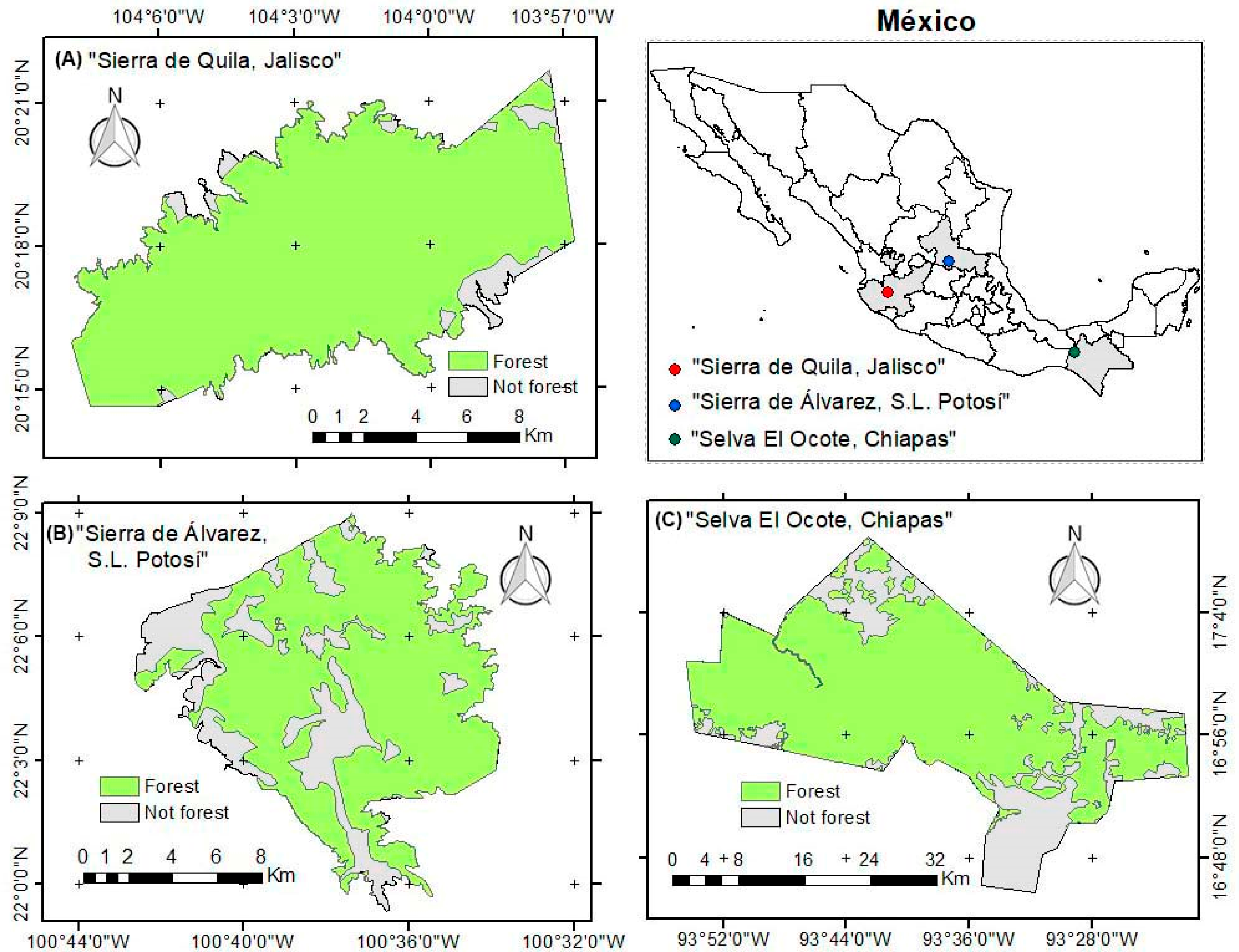
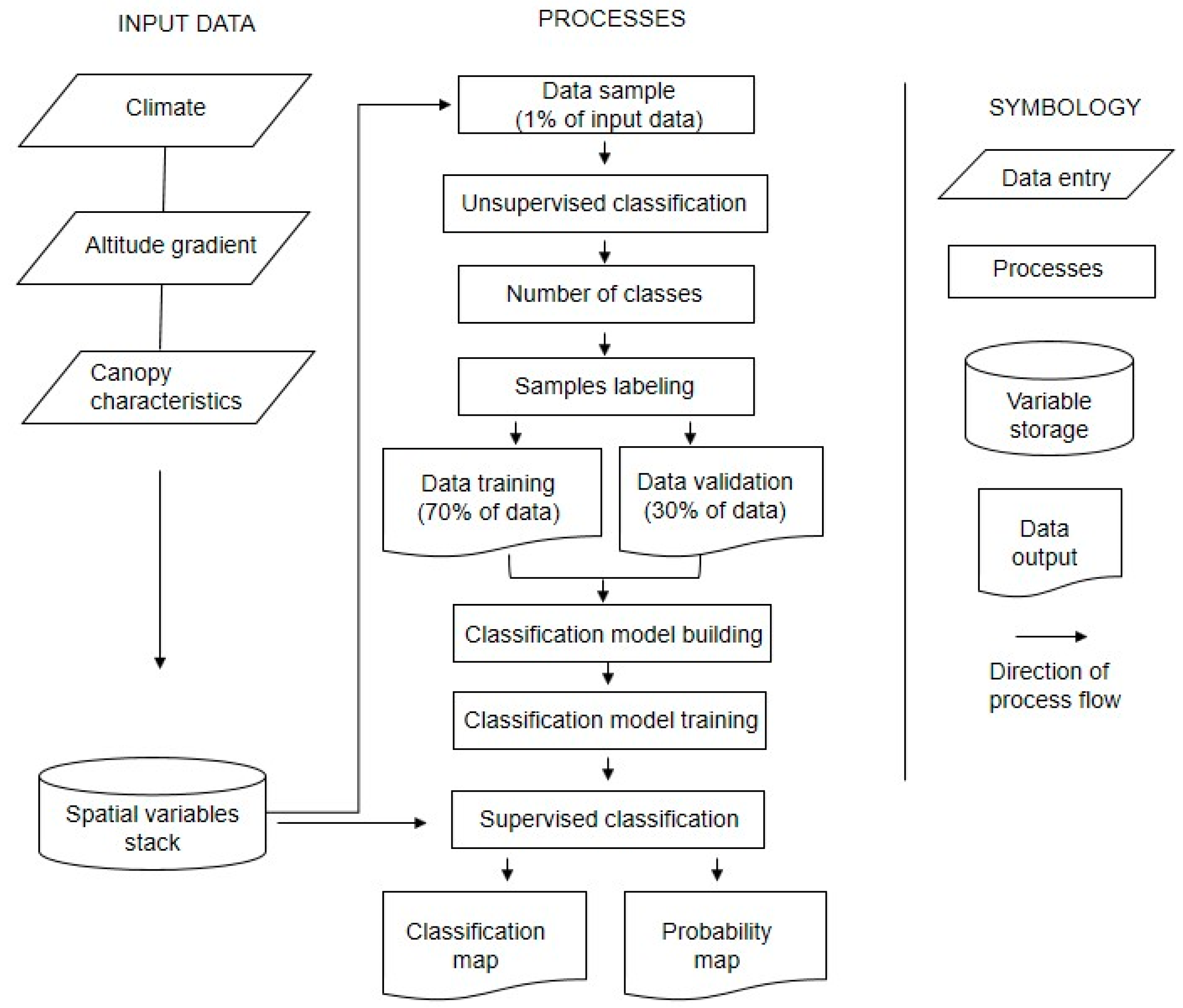
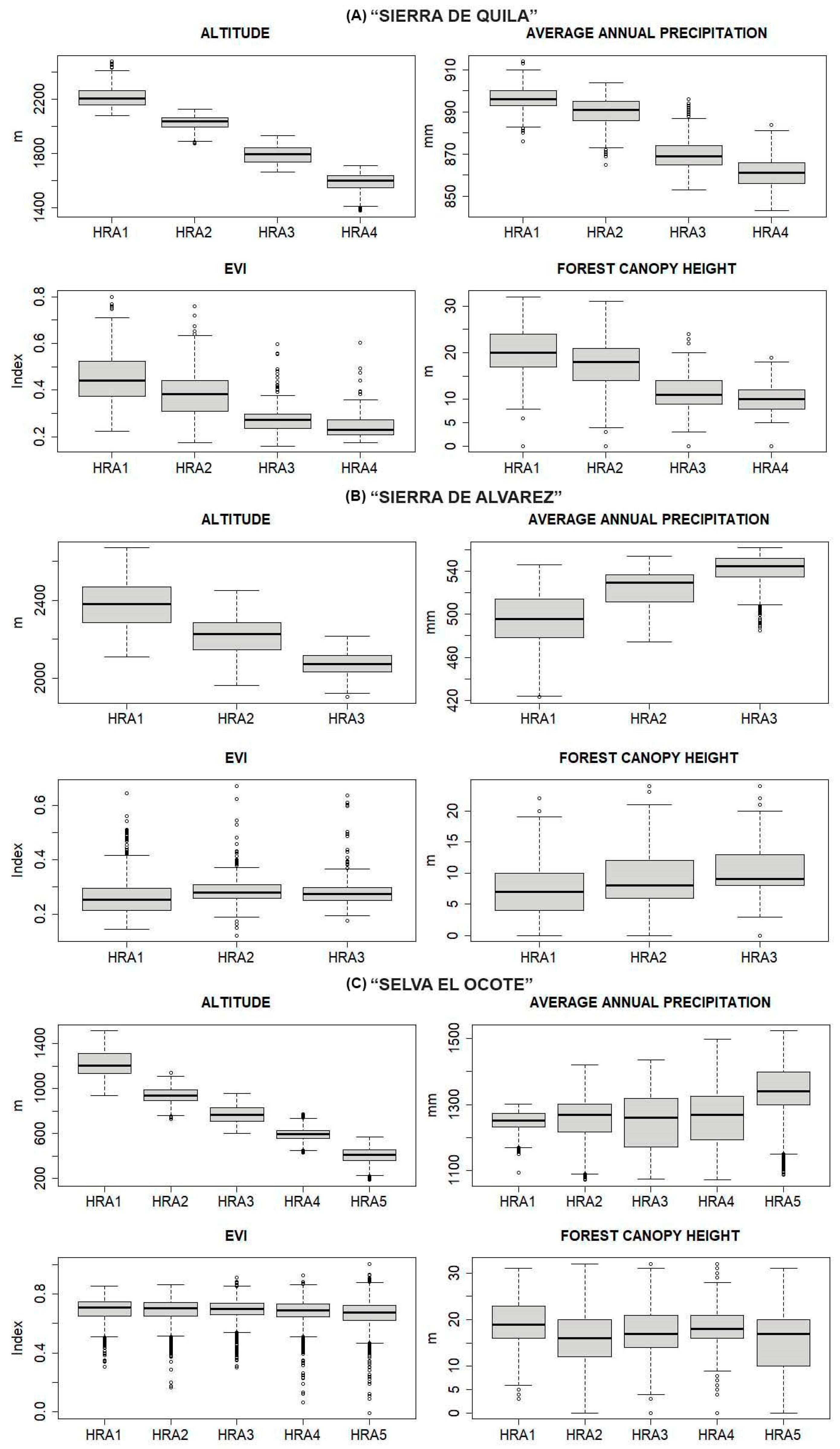
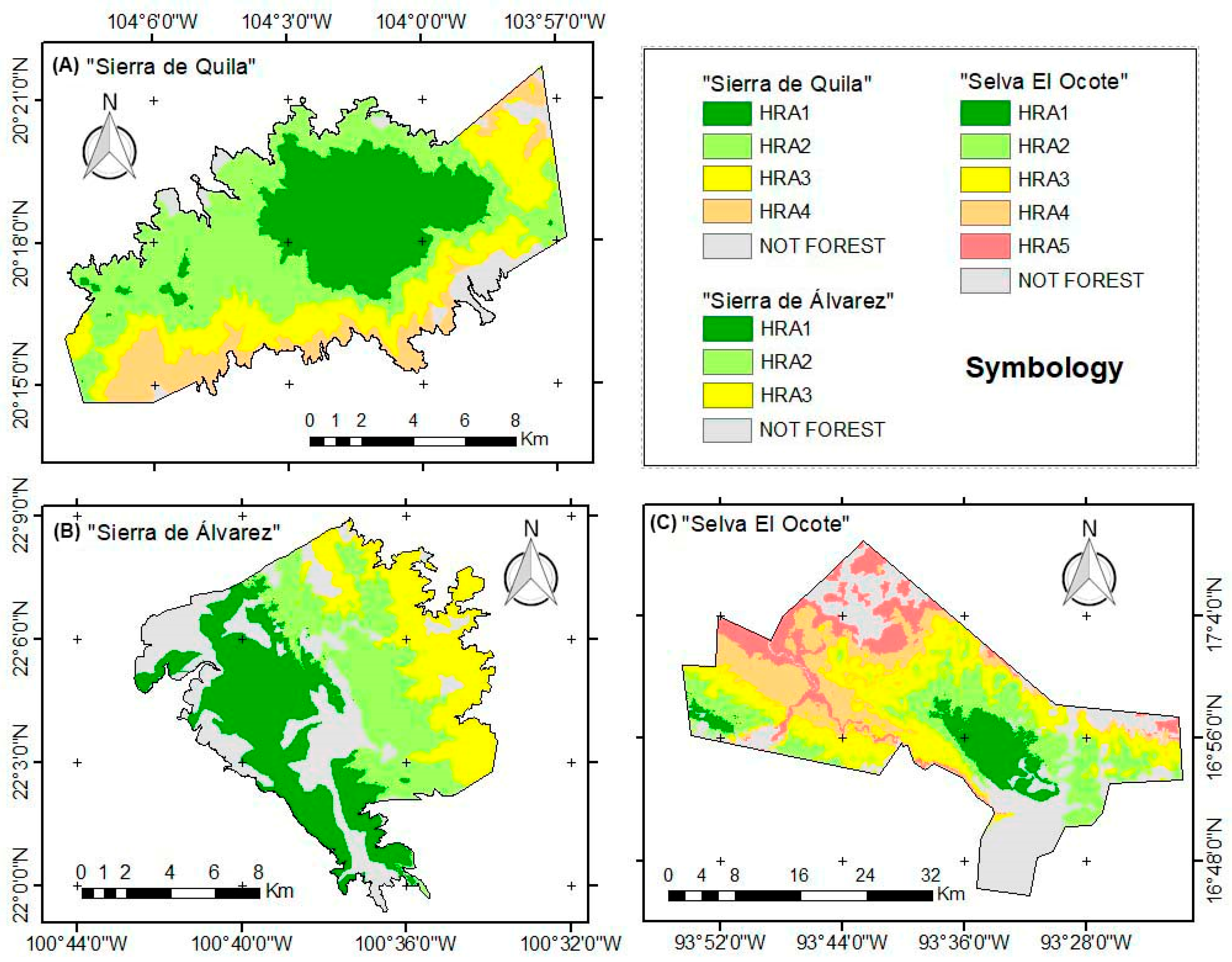
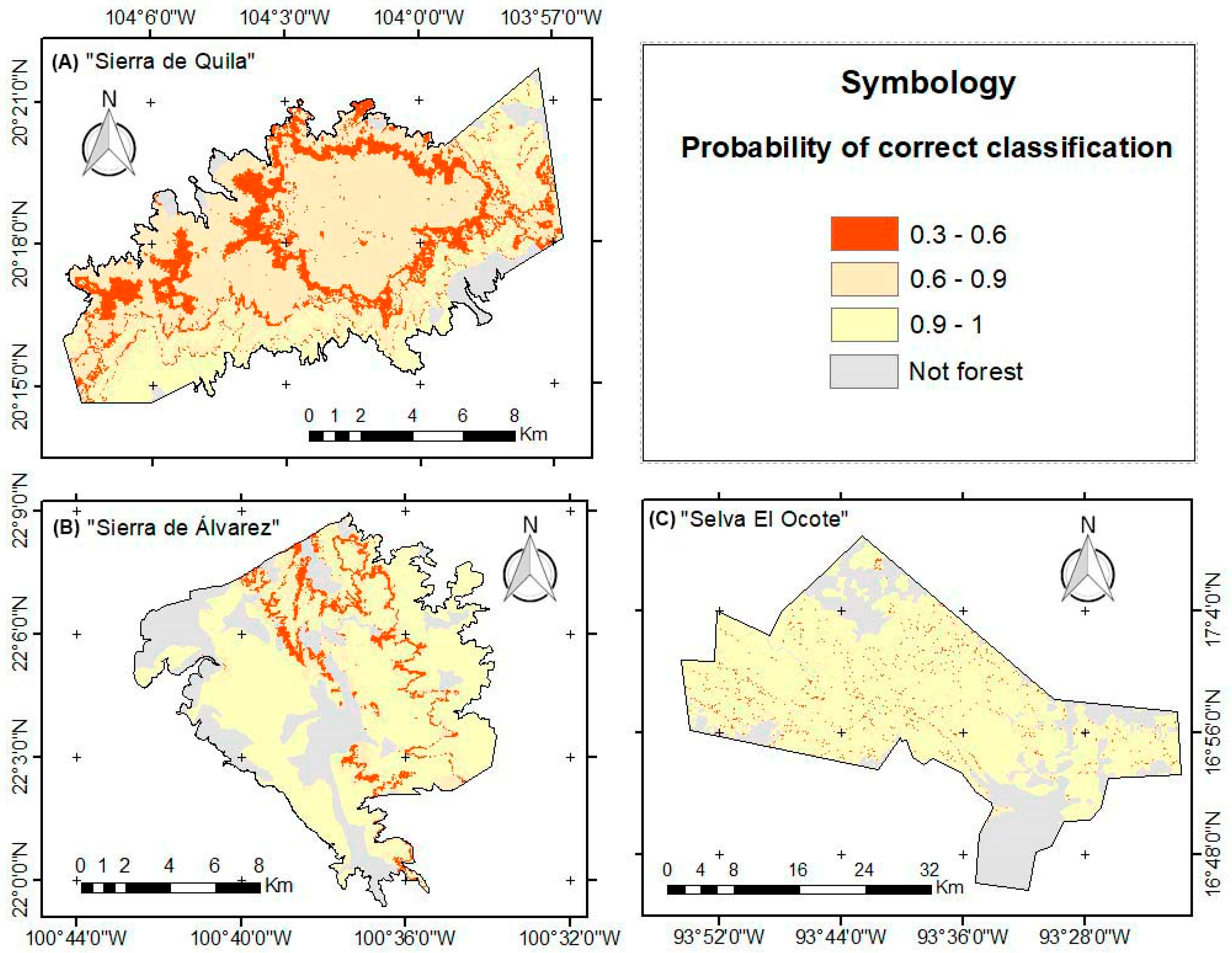
| HRA1 | HRA2 | HRA3 | HRA4 | Total | Prod.Accu | |
|---|---|---|---|---|---|---|
| HRA1 | 119 | 3 | 0 | 0 | 122 | 97.54% |
| HRA2 | 0 | 175 | 2 | 0 | 177 | 98.87% |
| HRA3 | 0 | 0 | 91 | 3 | 94 | 96.81% |
| HRA4 | 0 | 0 | 2 | 55 | 57 | 96.49% |
| Total | 119 | 178 | 95 | 58 | 97.78% | Overall |
| User.Accu | 100.00% | 98.31% | 95.79% | 94.83% |
| HRA1 | HRA2 | HRA3 | Total | Prod.Accu | |
|---|---|---|---|---|---|
| HRA1 | 132 | 0 | 0 | 132 | 100.00% |
| HRA2 | 3 | 117 | 0 | 120 | 97.50% |
| HRA3 | 0 | 4 | 104 | 108 | 96.30% |
| Total | 135 | 121 | 104 | 98.06% | Overall |
| User.Accu | 97.78% | 96.69% | 100.00% |
| HRA1 | HRA2 | HRA3 | HRA4 | HRA5 | Total | Prod.Accu | |
|---|---|---|---|---|---|---|---|
| HRA1 | 232 | 3 | 0 | 0 | 0 | 235 | 98.72% |
| HRA2 | 0 | 686 | 10 | 0 | 0 | 696 | 98.56% |
| HRA3 | 0 | 3 | 725 | 6 | 0 | 734 | 98.77% |
| HRA4 | 0 | 0 | 12 | 544 | 4 | 560 | 97.14% |
| HRA5 | 0 | 0 | 0 | 3 | 366 | 369 | 99.19% |
| Total | 232 | 692 | 747 | 553 | 370 | 98.42% | Overall |
| User.Accu | 100% | 99.13% | 97.05% | 98.37% | 98.92% |
| Altitude | AAP | EVI | FCH | |
|---|---|---|---|---|
| “Sierra de Quila” | 74.09% | 17.19% | 7.54% | 1.18% |
| “Sierra de Álvarez” | 52.51% | 36.02% | 8.12% | 3.35% |
| “Selva El Ocote” | 80.34% | 14.98% | 2.37% | 2.31% |
Publisher’s Note: MDPI stays neutral with regard to jurisdictional claims in published maps and institutional affiliations. |
© 2022 by the authors. Licensee MDPI, Basel, Switzerland. This article is an open access article distributed under the terms and conditions of the Creative Commons Attribution (CC BY) license (https://creativecommons.org/licenses/by/4.0/).
Share and Cite
Chávez-Durán, Á.A.; Olvera-Vargas, M.; Figueroa-Rangel, B.; García, M.; Aguado, I.; Ruiz-Corral, J.A. Mapping Homogeneous Response Areas for Forest Fuel Management Using Geospatial Data, K-Means, and Random Forest Classification. Forests 2022, 13, 1970. https://doi.org/10.3390/f13121970
Chávez-Durán ÁA, Olvera-Vargas M, Figueroa-Rangel B, García M, Aguado I, Ruiz-Corral JA. Mapping Homogeneous Response Areas for Forest Fuel Management Using Geospatial Data, K-Means, and Random Forest Classification. Forests. 2022; 13(12):1970. https://doi.org/10.3390/f13121970
Chicago/Turabian StyleChávez-Durán, Álvaro Agustín, Miguel Olvera-Vargas, Blanca Figueroa-Rangel, Mariano García, Inmaculada Aguado, and José Ariel Ruiz-Corral. 2022. "Mapping Homogeneous Response Areas for Forest Fuel Management Using Geospatial Data, K-Means, and Random Forest Classification" Forests 13, no. 12: 1970. https://doi.org/10.3390/f13121970
APA StyleChávez-Durán, Á. A., Olvera-Vargas, M., Figueroa-Rangel, B., García, M., Aguado, I., & Ruiz-Corral, J. A. (2022). Mapping Homogeneous Response Areas for Forest Fuel Management Using Geospatial Data, K-Means, and Random Forest Classification. Forests, 13(12), 1970. https://doi.org/10.3390/f13121970







